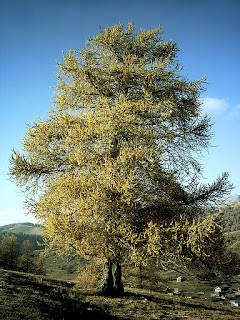 Larches look for the entire world
like evergreen trees. Larches are conifers in the genus Larix, in the family
Pinaceae. Larch is also called Larix, is a long waving twigs have tufts of
small needles; they even have cones. But come fall those needles turn yellow
and fall off just like the leaves of any deciduous tree. And the wood is more
like that of deciduous hardwood trees than the softer wooded evergreens. Larches
are among the dominant plants in the boreal forests of Siberia and Canada.
Although they are conifers, larches are deciduous trees that lose their needles
in the autumn.
Larches look for the entire world
like evergreen trees. Larches are conifers in the genus Larix, in the family
Pinaceae. Larch is also called Larix, is a long waving twigs have tufts of
small needles; they even have cones. But come fall those needles turn yellow
and fall off just like the leaves of any deciduous tree. And the wood is more
like that of deciduous hardwood trees than the softer wooded evergreens. Larches
are among the dominant plants in the boreal forests of Siberia and Canada.
Although they are conifers, larches are deciduous trees that lose their needles
in the autumn.
Larches are beautiful in the wild;
a stand of them will turn a hillside a bright pale green in early spring when
the needles start to grow, and bright yellow in fall. But have also lived with
a larch on the lawn, as a specimen tree, and found it a handsome unusual
accent. The Native American larch “Larix laricina” also called “eastern larch”
and “tamarack” grows as tall as 90 feet in an open pyramid. Larches are among
the few deciduous conifers, which are mostly evergreen. Other deciduous conifers
include the golden larch Pseudolarix amabilis, the dawn redwood Metasequoia
glyptostroboides, the Chinese swamp cypress Glyptostrobus pensilis and the bald
cypresses in the genus Taxodium.
It is fast growing and one of the
hardies trees known. It will even live in Zone 1, regions of which are simply referred
to as”the tamarack” because that’s about all threat grows there. European larch
“L. deciduas” hardy to Zone 2, is taller and is perhaps best known for the
variety L. d. “Pendula” whose climbs have gracefully drooping side branches.
Moreover Japanese Larch “L. leptolepsis or L. kaempferi” hardy to zone 4, is
also pendulous, with peeling bark. It grows very fast and is more resistant to
canker than other larches. Source: Chrismaticplanet.com

Well, to grow Larch, you need a
cool climate. They prefer a sunny location and deep fertile, rather acid soil
that is moist but well drained. They are easy to transplant but are best
planted balled and bur-lapped in fall or early spring. Larches rarely need
pruning. Lower branches can be removed from head room of if they are week and
straggly. The trees should have a central leader; if that is damaged replace
with another branch as described in the listing for fir.

















































